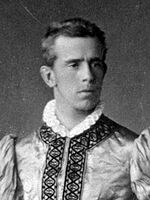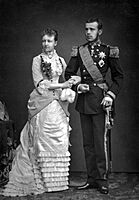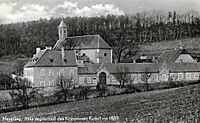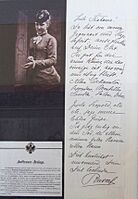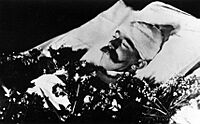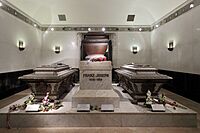Rudolf, Crown Prince of Austria facts for kids
Quick facts for kids Rudolf |
|||||
|---|---|---|---|---|---|
| Crown Prince of Austria Prince Royal of Hungary and Bohemia |
|||||

Rudolf in 1887
|
|||||
| Born | 21 August 1858 Schloss Laxenburg, Laxenburg, Lower Austria, Austrian Empire |
||||
| Died | 30 January 1889 (aged 30) Mayerling, Lower Austria, Austria-Hungary |
||||
| Burial | Imperial Crypt, Vienna | ||||
| Spouse | |||||
| Issue | Elisabeth Marie, Princess Otto of Windisch-Graetz | ||||
|
|||||
| House | Habsburg-Lorraine | ||||
| Father | Franz Joseph I of Austria | ||||
| Mother | Elisabeth in Bavaria | ||||
| Religion | Roman Catholicism | ||||
| Signature |  |
||||
Rudolf, Crown Prince of Austria (Rudolf Franz Karl Josef; 21 August 1858 – 30 January 1889) was the only son and third child of Emperor Franz Joseph I of Austria and Duchess Elisabeth of Bavaria (Sisi). He was heir apparent to the imperial throne of the Austro-Hungarian Empire from birth.
Contents
Background

Rudolf was born at Schloss Laxenburg, a castle near Vienna, as the son of Emperor Franz Joseph I and Empress Elisabeth. He was named after the first Habsburg King of Germany, Rudolf I, who reigned from 1273 to 1291. Rudolf was raised together with his older sister Gisela and the two were very close. At the age of six, Rudolf was separated from his sister as he began his education to become a future Emperor of Austria. This did not change their relationship and Gisela remained close to him until she left Vienna upon her marriage to Prince Leopold of Bavaria.
Influenced by his tutor Ferdinand von Hochstetter (who later became the first superintendent of the Imperial Natural History Museum), Rudolf became very interested in natural sciences, starting a mineral collection at an early age. After his death, large portions of his mineral collection came into the possession of the University of Agriculture in Vienna, which is now known as the University of Natural Resources and Life Sciences, Vienna
In 1877, the Count of Bombelles was master of the young prince. Bombelles had been the custodian of Rudolf's aunt Empress Charlotte of Mexico.
In contrast with his deeply conservative father, Rudolf held liberal views that were closer to those of his mother. Nevertheless, his relationship with her was at times strained.
Marriage
In Vienna, on 10 May 1881, Rudolf married Princess Stéphanie of Belgium, a daughter of King Leopold II of Belgium, at the Augustinian Church in Vienna. Although their marriage was initially a happy one, by the time their only child, the Archduchess Elisabeth, was born on 2 September 1883, the couple had drifted apart.
In 1886, Rudolf became seriously ill and the couple was directed to the island of Lacroma (present day Croatia) for his treatment. In transit, Stéphanie also became seriously ill and described "suffering terrible pain". The couple's diagnosis of peritonitis was kept secret by order of the Emperor.
By 1889, it was common knowledge at Court that Stéphanie would not have any more children due to the events of 1886, and that Rudolf's health was deteriorating.
Aftermath of death
Rudolf's death plunged his mother, Empress Elisabeth, into despair. She wore black or pearl grey, the colours of mourning, for the rest of her life and spent more and more time away from the imperial court in Vienna. In 1898, while Elisabeth was abroad in Geneva, Switzerland, she was murdered by an Italian anarchist, Luigi Lucheni.
Rudolf's death had left Franz Joseph without a direct male heir. Franz-Joseph's younger brother, Archduke Karl Ludwig, was next in line to the Austro-Hungarian throne, though it was falsely reported that he had renounced his succession rights. In any case, his death in 1896 from typhoid made his eldest son, Archduke Franz Ferdinand, the new heir presumptive. However, Archduke Franz Ferdinand was assassinated in 1914 (an event that precipitated World War I), so when Emperor Franz-Joseph died in November 1916, he was succeeded instead by his grandnephew, Charles I of Austria. The demands of the American President, Woodrow Wilson forced Emperor Charles I to renounce involvement in state affairs in Vienna in early November 1918. As a result, the Austro-Hungarian Empire ceased to exist and a republic came into being without revolution. Charles I and his family went into exile in Switzerland after spending a short time at Castle Eckartsau.
Titles, styles and honours
Titles and styles
- 21 August 1858 – 30 January 1889: His Imperial and Royal Highness The Crown Prince of Austria, Hungary, Bohemia and Croatia
Honours
- Domestic
- Knight of the Golden Fleece, 1858
- Grand Cross of the Royal Hungarian Order of St. Stephen, 1877
- Foreign
 Baden:
Baden:
- Knight of the House Order of Fidelity, 1873
- Grand Cross of the Zähringer Lion, 1873
 Bavaria: Knight of St. Hubert, in Diamonds, 1868
Bavaria: Knight of St. Hubert, in Diamonds, 1868 Belgium: Grand Cordon of the Order of Leopold, 1880 – wedding gift
Belgium: Grand Cordon of the Order of Leopold, 1880 – wedding gift Brazil: Grand Cross of the Southern Cross
Brazil: Grand Cross of the Southern Cross Denmark: Knight of the Elephant, 24 November 1873
Denmark: Knight of the Elephant, 24 November 1873

 Ernestine duchies: Grand Cross of the Saxe-Ernestine House Order
Ernestine duchies: Grand Cross of the Saxe-Ernestine House Order France: Grand Cross of the Legion of Honour
France: Grand Cross of the Legion of Honour Greece: Grand Cross of the Redeemer
Greece: Grand Cross of the Redeemer Hesse and by Rhine: Grand Cross of the Ludwig Order, 21 August 1865
Hesse and by Rhine: Grand Cross of the Ludwig Order, 21 August 1865 Italy: Knight of the Annunciation, 6 May 1881
Italy: Knight of the Annunciation, 6 May 1881
 Parmese Ducal Family: Grand Cross of the Constantinian Order of St. George
Parmese Ducal Family: Grand Cross of the Constantinian Order of St. George Tuscan Grand Ducal Family: Grand Cross of St. Joseph
Tuscan Grand Ducal Family: Grand Cross of St. Joseph
 Sovereign Military Order of Malta: Bailiff Grand Cross of Honour and Devotion
Sovereign Military Order of Malta: Bailiff Grand Cross of Honour and Devotion Japan: Grand Cordon of the Order of the Chrysanthemum, 14 February 1881
Japan: Grand Cordon of the Order of the Chrysanthemum, 14 February 1881 Mecklenburg: Grand Cross of the Wendish Crown, with Crown in Ore
Mecklenburg: Grand Cross of the Wendish Crown, with Crown in Ore Mexican Empire: Grand Cross of the Mexican Eagle, 1865
Mexican Empire: Grand Cross of the Mexican Eagle, 1865 Montenegro: Grand Cross of the Order of Prince Danilo I
Montenegro: Grand Cross of the Order of Prince Danilo I Nassau Ducal Family: Knight of the Gold Lion of Nassau
Nassau Ducal Family: Knight of the Gold Lion of Nassau Netherlands: Grand Cross of the Netherlands Lion
Netherlands: Grand Cross of the Netherlands Lion Ottoman Empire: Order of Osmanieh, 1st Class
Ottoman Empire: Order of Osmanieh, 1st Class Tunisia: Husainid Family Order, in Diamonds
Tunisia: Husainid Family Order, in Diamonds Persia: Order of the August Portrait, in Diamonds, 1 August 1873
Persia: Order of the August Portrait, in Diamonds, 1 August 1873 Portugal: Grand Cross of the Sash of the Two Orders
Portugal: Grand Cross of the Sash of the Two Orders Prussia:
Prussia:
- Knight of the Black Eagle, 21 August 1864
- Grand Commander's Cross of the Royal House Order of Hohenzollern
 Russia:
Russia:
- Knight of St. Andrew, 1878
- Knight of St. Alexander Nevsky
- Knight of the White Eagle
- Knight of St. Anna, 1st Class
- Knight of St. Stanislaus, 1st Class
 Romania: Grand Cross of the Star of Romania
Romania: Grand Cross of the Star of Romania San Marino: Grand Cross of the Order of San Marino
San Marino: Grand Cross of the Order of San Marino Serbia: Grand Cross of the Cross of Takovo
Serbia: Grand Cross of the Cross of Takovo Saxe-Weimar-Eisenach: Grand Cross of the White Falcon, 1873
Saxe-Weimar-Eisenach: Grand Cross of the White Falcon, 1873 Saxony: Knight of the Rue Crown, 1876
Saxony: Knight of the Rue Crown, 1876 Siam:
Siam:
- Grand Cross of the White Elephant
- Grand Cross of the Crown of Siam
 Spain: Grand Cross of the Order of Charles III, 5 June 1875
Spain: Grand Cross of the Order of Charles III, 5 June 1875
 Sweden-Norway: Knight of the Seraphim, 15 April 1879
Sweden-Norway: Knight of the Seraphim, 15 April 1879 United Kingdom:
United Kingdom:
- Stranger Knight Companion of the Garter, 20 June 1887
- Gold Medal Commemorating the Golden Jubilee of Queen Victoria
 Württemberg: Grand Cross of the Württemberg Crown, 1873
Württemberg: Grand Cross of the Württemberg Crown, 1873
Gallery
See also
 In Spanish: Rodolfo de Habsburgo (príncipe heredero de Austria) para niños
In Spanish: Rodolfo de Habsburgo (príncipe heredero de Austria) para niños
- Lake Rudolf
- Alma V. Hayne
- Rudolf Island
- List of heirs to the Austrian throne





